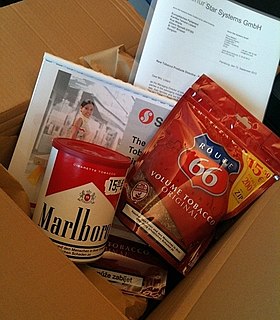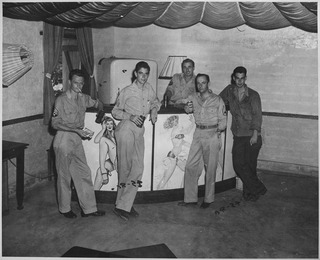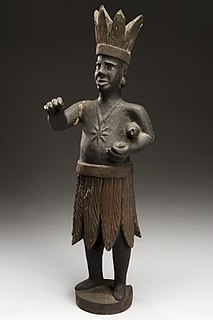Related Research Articles

A cigarette is a narrow cylinder containing a combustible material, typically tobacco, that is rolled into thin paper for smoking. The cigarette is ignited at one end, causing it to smolder; the resulting smoke is orally inhaled via the opposite end. Cigarette smoking is the most common method of tobacco consumption. The term cigarette, as commonly used, refers to a tobacco cigarette, but the word is sometimes used to refer to other substances, such as a cannabis cigarette or an herbal cigarette. A cigarette is distinguished from a cigar by its usually smaller size, use of processed leaf, and paper wrapping, which is typically white.

The tobacco industry comprises those persons and companies who are engaged in the growth, preparation for sale, shipment, advertisement, and distribution of tobacco and tobacco-related products. It is a global industry; tobacco can grow in any warm, moist environment, which means it can be farmed on all continents except Antarctica.

Passive smoking is the inhalation of tobacco smoke, called secondhand smoke (SHS), or environmental tobacco smoke (ETS), by persons other than the intended "active" smoker. It occurs when tobacco smoke enters an environment, causing its inhalation by people within that environment. Exposure to secondhand tobacco smoke causes disease, disability, and death. The health risks of secondhand smoke are a matter of scientific consensus. These risks have been a major motivation for smoke-free laws in workplaces and indoor public places, including restaurants, bars and night clubs, as well as some open public spaces.

Nicotine marketing is the marketing of nicotine-containing products or use. Traditionally, the tobacco industry markets cigarette smoking, but it is increasingly marketing other products, such as electronic cigarettes and heated tobacco products. Products are marketed through social media, stealth marketing, mass media, and sponsorship. Expenditures on nicotine marketing are in the tens of billions a year; in the US alone, spending was over US$1 million per hour in 2016; in 2003, per-capita marketing spending was $290 per adult smoker, or $45 per inhabitant. Nicotine marketing is increasingly regulated; some forms of nicotine advertising are banned in many countries. The World Health Organization recommends a complete tobacco advertising ban.
Operation Berkshire is the name of a program initiated in 1976 by seven of the world's major tobacco companies aimed at promoting "controversy" over smoking and disease.

Merit is an American brand of cigarettes, currently owned and manufactured by Philip Morris USA in the United States and Philip Morris International outside the United States.

A flavored tobacco product is a tobacco product with added flavorings. Flavored tobacco products include types of cigarettes, cigarillos and cigars, hookahs and hookah tobacco, various types of smokeless tobacco, and more recently electronic cigarettes. Flavored tobacco products are especially popular with youth and have therefore become targets of regulation in several countries.
Fire safe cigarettes, abbreviated "FSC", also known as lower ignition propensity (LIP), reduced fire risk (RFR), self-extinguishing, fire-safe or reduced ignition propensity (RIP) cigarettes, are cigarettes that are designed to extinguish more quickly than standard cigarettes if ignored, with the intention of preventing accidental fires. In the United States, "FSC" above the barcode signifies that the cigarettes sold are fire standards compliant (FSC).
The Tobacco Institute, Inc. was a United States tobacco industry trade group, founded in 1958 by the American tobacco industry. It was dissolved in 1998 as part of the Tobacco Master Settlement Agreement.

Tobacco politics refers to the politics surrounding the use and distribution of tobacco.
Tobacco marketing targeting African-Americans refers to the practice of customizing tobacco products and advertising techniques specifically to African-American consumers. It is most commonly analyzed through the consumption of mentholated cigarettes, as it represents 47% of black adult smokers and 84% of adolescent black smokers.

Smoking in the United States military has been observed in previous wars, but smoking's close association with the United States military started in World War I when tobacco companies began to target military personnel through the distribution of cigarettes to servicemen and the eventual inclusion of cigarettes into rations. Although the military has attempted to implement tobacco control initiatives, the association between smoking and military personnel has persisted to the present day as smoking rates remain high, despite declines in civilian rates. Such high rates have led to questions about the effect of smoking from the apparent health risks to troop readiness and training costs.
Smoking in Ecuador is more common among men and younger people. According to a study in 2004, 49.4% of men and 13.1% of women smoke. More than half of Ecuadorian smokers desire to quit. The Government of Ecuador plans to reduce second-hand smoke in public spaces by 2012. The tobacco industry in Ecuador includes the major players of Tabacalera Andina SA and British American Tobacco Ltd. Smoking is expected to decrease as the government enacts laws and the public becomes more aware of the dangers of smoking. Smoking is common in bars and dance clubs, but non-smoking signs in restaurants in Quito are generally respected.

Putera Sampoerna Foundation (PSF) is a social business institution in Indonesia, founded by tobacco heir Putera Sampoerna. PSF is a consultant for, and operator of, corporate social responsibility programs. The Foundation has 4 focuses of influence: ""quality education for high-achieving, but underprivileged students, job creation through entrepreneurship development programs, public enlightenment through the empowerment of women, and the distribution of aid and relief programs for compassionate and disaster relief."

Norbert Hirschhorn is an Austrian-born American public health physician. He was one of the inventors and developers of the life-saving method called oral rehydration therapy for adults and children suffering fluid loss from cholera and other infectious diarrheal illnesses. It is estimated that his work has saved around 50 million people suffering from dehydration.
The Center for Indoor Air Research was a tobacco industry front group established by three American tobacco companies—Philip Morris, R.J. Reynolds, and Lorillard—in Linthicum, Maryland, in 1988. The organization funded research on indoor air pollution, some of which pertained to passive smoking and some of which did not. It also funded research pertaining to causes of lung cancer other than passive smoking, such as diet. The organization disbanded in 1998 as a result of the Tobacco Master Settlement Agreement.
A heated tobacco product (HTP) is a tobacco product that heats the tobacco at a lower temperature than conventional cigarettes. These products contain nicotine, which is a highly addictive chemical. The heat generates an aerosol or smoke to be inhaled from the tobacco, which contains nicotine and other chemicals. HTPs may also contain additives not found in tobacco, including flavoring chemicals. HTPs generally heat tobacco to temperatures under 600 °C (1100 °F), a lower temperature than conventional cigarettes. HTPs use embedded or external heat sources, heated sealed chambers, or product-specific customized cigarettes. Whereas e-cigarettes are electronic devices that vaporize a liquid containing nicotine, HTPs usually use tobacco in leaf or some other solid form, although there are some hybrid products that can use both solid tobacco and e-liquids. There are various types of HTPs. The two most common designs are those that use an electric battery to heat tobacco leaf and those that use a carbon ember that is lit and then heats the tobacco. There are similar devices that heat cannabis instead of tobacco.

The history of nicotine marketing stretches back centuries. Nicotine marketing has continually developed new techniques in response to historical circumstances, societal and technological change, and regulation. Countermarketing has also changed, in both message and commonness, over the decades, often in response to pro-nicotine marketing.

Iqos is a line of heated tobacco and electronic cigarette products manufactured by Philip Morris International (PMI). It was first introduced in November 2014 with the launch of the Iqos tobacco heating device in Japan and Italy, before being gradually commercialized in other countries.
References
- 1 2 3 Hirschhorn, N. (1 September 2001). "Philip Morris' new scientific initiative: an analysis". Tobacco Control. 10 (3): 247–252. doi:10.1136/tc.10.3.247. PMC 1747596 . PMID 11544389.
- 1 2 Grimm, D. (29 February 2008). "RESEARCH FUNDING: Philip Morris Pulls the Plug on Controversial Research Program". Science. 319 (5867): 1173a. doi:10.1126/science.319.5867.1173a. PMID 18309055. S2CID 39890112.
- ↑ Ress, David (14 December 2008). "Program for young scientists is retired". Richmond Times-Dispatch. Retrieved 24 August 2015.
- ↑ Bero, LA (2005). "Tobacco industry manipulation of research". Public Health Reports. 120 (2): 200–8. doi:10.1177/003335490512000215. PMC 1497700 . PMID 15842123.
- ↑ Hirschhorn, N (1 June 2006). "The Philip Morris External Research Program: results from the first round of projects". Tobacco Control. 15 (3): 267–269. doi:10.1136/tc.2005.012799. PMC 2564674 . PMID 16728760.
- ↑ Huckabee, Charles (29 February 2008). "Philip Morris Shuts Down Grant Program for University Research". Chronicle of Higher Education. Retrieved 24 August 2015.